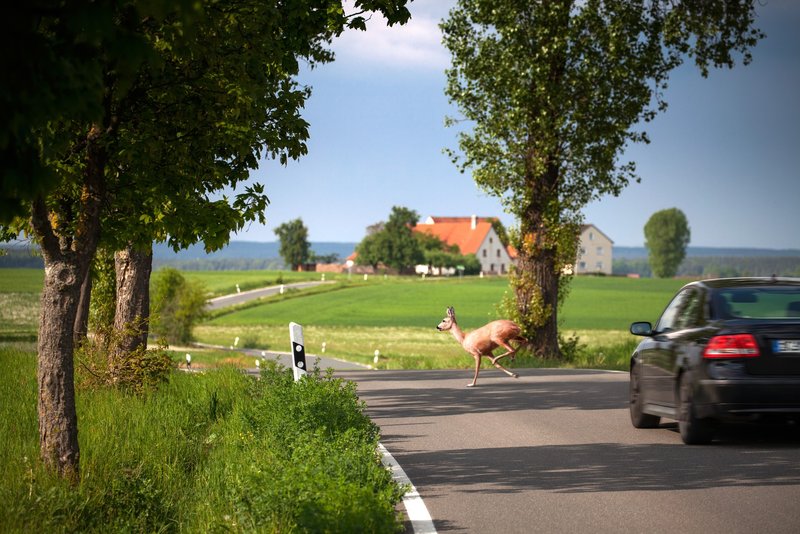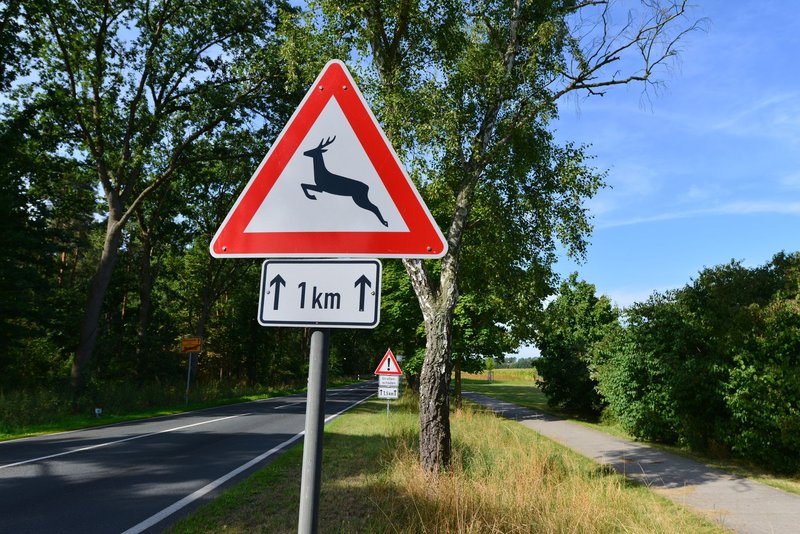When do accidents involving wildlife happen especially often?
The risk of an accident involving game is highest in spring, in the months of April and May, and in autumn from October to December. At these times the animals are more active, as they go looking for suitable habitats, or due to the mating season, and they thus cover longer distances. This also increases the number of road crossings.
At the same time, many wild animals are active at dusk and at night, which is why accidents involving wildlife tend to occur more frequently at these times of day. This aspect is particularly relevant when the clocks go back in autumn. Then the activity of the wild animals at dusk coincides with commuter traffic, and the probability of accidents with wild animals occurring rises.
Where is the probability of game crossing especially high?
In general, wildlife crossings can be expected anywhere. However, the probability is highest in transitional areas between forests and fields, because the animals tend to emerge from the forest into the fields in the morning to search for food, and switch back again in the evening.

Fig. 1: Deer are the animals most frequently affected by accidents with wildlife, with around 200,000 documented casualties nationwide per year.
© hykoe – stock.adobe.com
Which wild animals are most often the victims of accidents involving game ?
Deer are most frequently affected by wildlife accidents, with around 200,000 documented casualties nationwide, followed by wild boar with 31,000 cases recorded. Other animal species such as fox or hare are also frequent victims of wildlife accidents, but there are no overall figures available for these species at national level.
Collision with a wild animal on a car journey. How should I behave?
If you can no longer avoid a collision, you should brake and hold the steering wheel as firmly as possible. It is better to risk a collision than to swerve uncontrollably - this could cause you to run into oncoming traffic.
After the collision, the first thing to do is to secure the scene of the accident (switch on your hazard warning lights, put on a high-visibility vest, set up a warning triangle) and, if necessary, administer first aid. Then you must report the accident to the police by ringing 110 and, if possible, you should pull the dead animal off the road (put gloves on!).
If the driver of a vehicle does not report a wildlife accident immediately, this may constitute an offence under § 4 (4) and § 67 (2) No. 1 of the [German national] Hunting and Wildlife Management Act (JWMG).
Can I approach an injured animal?
Wild animals that are still alive may react unpredictably and also aggressively as a result of any injuries they have sustained and the stress triggered by the accident. You should thus keep a safe distance from the animal, so that it can calm down. If it calms down, this will also ensure that the animal does not run away, and a local hunter can release the animal from its pain if necessary.
Am I allowed to remove the animal from the scene of the accident?
No. Anyone who takes roadkill with them is guilty of poaching.
Who pays for damage to the vehicle and at the scene of the accident?
If you have partially comprehensive insurance, the damage to the vehicle is usually covered by the insurance if it is an accident with “furred game” (roe deer, wild boar, foxes, hares, red deer, martens or badgers). The exact cover is specified in the individual contract conditions of the respective insurance policies concluded.
For the settlement of vehicle damages, proof that the accident with wildlife actually took place is required in the form of an accident report certificate. This is issued by the local hunter or the police on site.
Comprehensive insurance policies also cover damage caused by accidents involving wildlife even if there is no proof that it was a wildlife accident.

Fig. 2: Road sign “Beware of deer crossing”.
© nmann77 – stock.adobe.com
What can I do as a driver to reduce the likelihood of having an accident with game?
- In twilight and at night, drive attentively and at an appropriate speed. That way you can react in time if wild animals appear at the roadside or on the road.
- If you see the traffic sign “Beware of deer crossing”, it indicates that this is a black spot for wildlife accidents. This means that several accidents involving wildlife have already occurred in the area. You should therefore reduce speed.
- If you see a wild animal at the roadside, you should be aware that other wild animals may well also appear and cross the road.
- If you spot a wild animal, dim your headlights. That way, the animals are not blinded and you avoid causing a panic reaction.
- Honk to drive away any (more) animals.
